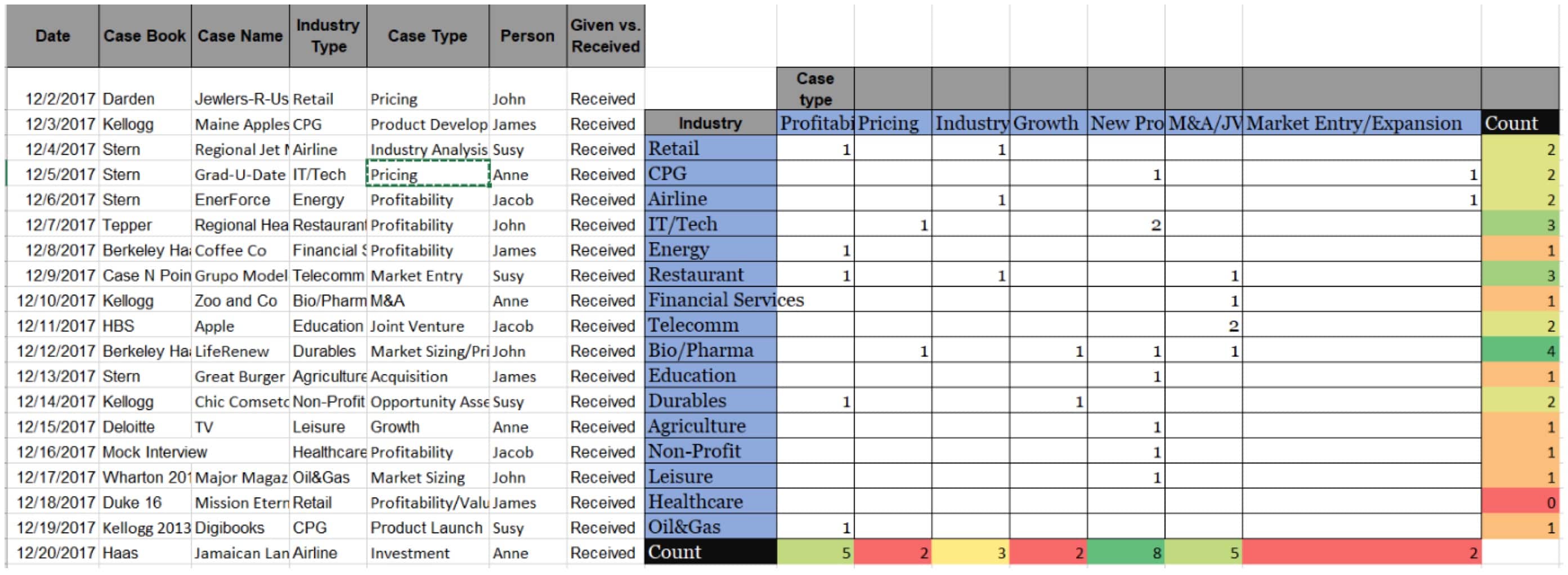Whether you’re recruiting for consulting via a graduate program or going it alone, the process is extremely time-consuming and chaotic. Effectively managing the flood of information on companies, contacts, and case-prep is half the battle.
In this piece, I will arm you with a few simple tools (templates) that will help to keep your recruiting activities organized.
While I can’t take credit for all of these tools (the Contacts and Casing ones were passed down by upperclassmen in the Management Consulting Association at Stern), I did use all of them during my own recruiting season and found them to be invaluable.
Companies (Applications)
Purpose: To keep track of which companies you are applying to/have applied to.
You won’t get an offer if you miss a deadline…so this might be the most important template of them all!
A few tips to leveraging this template effectively:
- Aim to have complete information; sit down and update this sheet every few days.
- Fill in all base information in one go if you can (all companies, deadline, recruiter info, position name, application link).
- Leverage the color coding and filters to target your efforts. This will help you to keep track of rapidly upcoming application deadlines, and you can also filter on company to double-check cover letter accuracy regarding the position, offices, and recruiter.
Contacts (Keep in the cloud to allow frequent updating)
Purpose: To track all company employees with whom you established some sort of rapport.
Recruiting is nothing without aggressive networking and contact management. In the midst of recruiting season, I was updating this sheet multiple times a day.
- TY Email – Have you sent a thank you email yet? The answer should always be “Yes”; emails should be sent within 24 hours of meeting the person.
- Inform Them If Accepted – If they say, “Let me know how it goes,” or respond promisingly to your thank you email, let them know later if you got an interview and/or offer! Also, let them know when you’ve submitted your application.
- Notes – If on the phone or having coffee, take (quick) notes on the conversation. If meeting at an event or a less “informational” setting, quickly jot notes down on a notecard/notepad after the conversation has ended. Notes should be used later to add a personal touch to your thank you letter and to remember who they are!
Cases
Purpose: To track cases both given and received.
Since casing takes a long time to master, you’re probably practicing cases at the same time as you’re recruiting. It’s just as important to keep track of this part of the job hunt as the “getting the interview” process.
The power of this sheet is two-fold. First, it allows you to identify which cases you can give to someone else as well as which ones are available for them to give to you. Second, it allows you to target your casing efforts more effectively by informing you where you have the least practice. This can allow you to kill two birds with one stone if you can find a case that is both the industry type and the case type that you need practice in.
Feel free to change the industry type, case type, and case source on this sheet based on the resources at your disposal.
Bonus: Industry-Function Heat Matrix
Purpose: To identify your preferred function and industry combinations.
I created this document post-recruiting, but I wish I had had it during recruiting to better talk to recruiters and employees about what interested me most. It also would have been extremely useful in conjunction with the contact tracking sheet. Ultimately, I used it during my internship to keep track of who I could reach out to for questions and to optimize my search for project staffing.
You should update the industry and function groupings based on how you view them, and, later on, based on how the company you are joining structures them.
Summary
You can download all four templates in one convenient excel file here.
Feel free to use the templates included and modify them in any way you see fit. Even if the exact templates don’t fall in line with the way you organize things, I hope the above has helped you to understand the major pieces of recruiting and how to think about them systematically.
Ian Glennon is an ex-MBB consultant who currently offers one-on-one coaching sessions to help you nail your consulting interview. Find out more here.
Image: Unsplash




